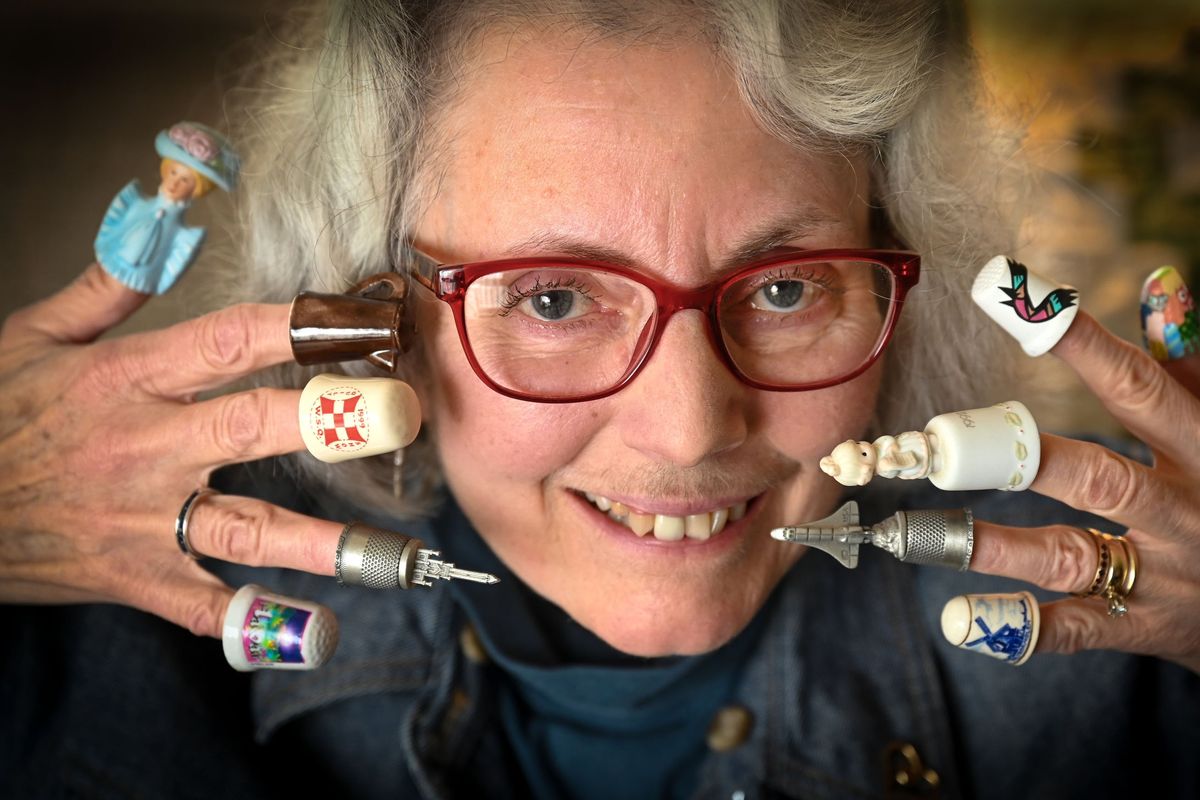The Collector: Family heirloom kicked off collection of thimbles

Like many collections, Ruth Danner’s started small – very small.
A tiny golden thimble, a wedding gift to her husband’s grandmother from her groom, launched an accumulation that now numbers 95.
The wedding date etched on the gift is difficult to decipher, but the month and year are clear: September 1916.
“It’s my oldest by far,” Danner said. “Granny married as a teen and used it her entire marriage.”
Granny gave the item to her daughter-in-law, who in turn, passed it on to Danner in the early 90s.
Danner, an author and retired educator, is no stranger to sewing notions. The avid quilter began sewing as a child under her mother’s tutelage.
“She taught 4-H, and I sat in on her classes for the older girls,” Danner said.
A shadow box purchased at an antique shop on North Monroe houses her thimbles made of pewter, glass, porcelain and wood. They come from varied locales including, Arkansas, Texas, New Mexico and Florida. Many were gifts.
She pointed to four musically-themed porcelain items.
“I taught piano and trumpet,” she said. “These were gifts from students.”
A pewter souvenir with the space shuttle jutting from its top was given to her by her niece.
“She got a scholarship to Space Camp and bought it for me.”
Another gift, a set of bisque Avon collectibles from the 1980s, came to her via her husband’s aunt.
“She was an Avon dealer in Arkansas,” Danner said. “She gave them to me. Each one represents an era in women’s fashion.”
A 1920s-era flapper wearing a yellow cloche perches next to a pink-clad woman with her hair styled in a Victory Roll popular in the ’40s.
While fun to look at, Danner acknowledges they’re too cumbersome to be useful. Likewise, her only leather thimble.
“It was made in Korea, and I found it at a sewing notions store,” she said. “Somebody recommended a leather one, but it never worked for me.”
Nor did one made of red rubber.
“The needle is supposed to stay on the head of the thimble to push it through the fabric,” explained Danner. “But the needle kept slipping off.”
The digitalbulist (thimble collector) enjoyed learning the history behind this unassuming staple of sewing boxes.
“Thimbles were originally called thumb balls because they went on thumbs,” she said.
The earliest versions made of bone and stone can be traced to the Neolithic age. Their function has always been to protect fingers while sewing. Danner said the first widely produced modern thimble came from England in 1695.
In addition to sewing, thimbles had other uses. For example, they came in handy for Victorian-era schoolteachers.
“They used to give ‘thimble thumps’ on the heads of misbehaving students,” said Danner.
In the 1800s, a thimbleful was a legitimate measure of alcohol. But the most surprising usage she discovered was “thimble knocking.”
“Prostitutes used them to tap on the windows of clients.”
Danner uses her collection to commemorate her travels. For example, a white ceramic thimble with a blue windmill came from Holland, and she discovered a patchwork painted Dutch clog at the airport in Amsterdam.
A tiny wooden one with a delicate painting of a bluebonnet, Texas’ state flower, reminds her of the 13 years she lived there. Ditto a plastic one from the Trinity Valley Quilters Guild.
A pewter version purchased at the Ponce de Leon Lighthouse in Florida brings memories of the two times she climbed 175 feet to enjoy the views from Florida’s tallest lighthouse.
“I almost always buy one when I travel,” Danner said. “And I’ve never bought one online.”
While she loves the sentimental history of Granny’s golden thimble, Danner’s true favorite must be held to the light to reveal its beauty. The delicate gold-trimmed glass thimble features a stained glass pattern with a red flower.
“I think it’s the prettiest,” she said.
A retired workhorse has a place of honor among her collectibles – a tiny hole worn through its metal top.
“I just love to quilt,” said Danner. “I quilt hundreds of hours a year, and things wear out.”
Her shadowbox still has room for more additions.
“The joy is in finding a new thimble,” she said. “And they’re getting harder and harder to find.”